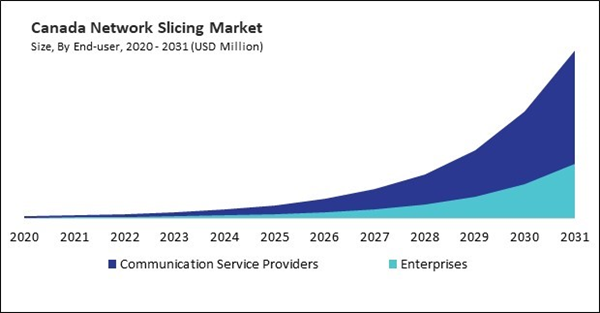The US market dominated the North America Network Slicing Market by Country in 2023, and would continue to be a dominant market till 2031; thereby, achieving a market value of $4,713.6 million by 2031. The Canada market is showcasing a CAGR of 52.6% during (2024 - 2031). Additionally, The Mexico market would register a CAGR of 51.2% during (2024 - 2031).
The data speed offered by 5G technology plays a crucial role in boosting the market by enabling new use cases, improving user experiences, optimizing resource allocation, and creating monetization opportunities for operators. The anticipated proliferation of 5G networks will generate substantial demand for network slicing solutions, thereby stimulating market expansion and fostering innovation within the telecommunications sector.
The market stands at the forefront of innovation, poised to revolutionize the telecommunications landscape with its transformative capabilities. At its core, it represents a paradigm shift in the way networks are architected, managed, and utilized, offering unprecedented levels of flexibility, customization, and efficiency. As industries undergo rapid digital transformation and embrace emerging technologies such as 5G, cloud computing, and IoT, the demand for agile and adaptable networking solutions has never been greater. The network slicing approach allows for isolating and customizing network resources, ensuring that each slice can be optimized to meet the diverse requirements of different services and applications.
The increasing adoption of telemedicine also contributes to the demand for network slicing technology in North America. According to the Centers for Disease Control and Prevention (CDC), 37.0% of adults aged 18 and over used telemedicine in 2021, increasing usage with age. This trend is expected to continue as telemedicine becomes more widely accepted and integrated into healthcare systems, highlighting the need for reliable, high-performance networks to support these services. Thus, the combination of a strong technology sector, a growing IT industry, and increasing adoption of telemedicine is driving the demand for network slicing technology in North America.
Based on Application, the market is segmented into Solution, and Services. Based on End-user, the market is segmented into Communication Service Providers, and Enterprises. Based on Vertical, the market is segmented into Healthcare, Transportation & Logistics, Energy & Utilities, Manufacturing, Media & Entertainment, Financial Services, Retail, Government, and Others. Based on countries, the market is segmented into U.S., Mexico, Canada, and Rest of North America.
List of Key Companies Profiled
- Ericsson AB
- Samsung Electronics Co., Ltd. (Samsung Group)
- Nokia Corporation
- Huawei Technologies Co., Ltd. (Huawei Investment & Holding Co., Ltd.)
- ZTE Corporation
- Cisco Systems Inc.
- Hewlett Packard Enterprise Company
- Intel Corporation
- VMware, Inc. (Broadcom Inc.)
- BT Group plc
Market Report Segmentation
By Application- Solution
- Services
- Communication Service Providers
- Enterprises
- Healthcare
- Transportation & Logistics
- Energy & Utilities
- Manufacturing
- Media & Entertainment
- Financial Services
- Retail
- Government
- Others
- US
- Canada
- Mexico
- Rest of North America
Table of Contents
Companies Mentioned
- Ericsson AB
- Samsung Electronics Co., Ltd. (Samsung Group)
- Nokia Corporation
- Huawei Technologies Co., Ltd. (Huawei Investment & Holding Co., Ltd.)
- ZTE Corporation
- Cisco Systems Inc.
- Hewlett Packard Enterprise Company
- Intel Corporation
- VMware, Inc. (Broadcom Inc.)
- BT Group plc
Methodology

LOADING...









